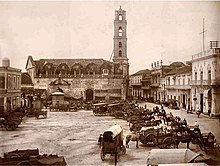Basilica of San Francisco de Asís, Havana
| Basílica Menor de San Francisco de Asís | |
|---|---|
 The basilica in 2016 | |
 | |
| General information | |
| Status | Active |
| Type | Catholic church |
| Architectural style | Baroque |
| Town or city | Havana |
| Country | Cuba |
| Coordinates | 23°08′13″N 82°20′54″W / 23.13694°N 82.34833°W |
| Height | 42 metres (138 ft) |
The Basílica Menor of San Francisco de Asís (English: Minor Basilica of Saint Francis of Assisi; also the Convento de San Francisco de Asis) is a
Public square
Plaza de San Francisco de Asís (
In 1761, José Martín Félix de Arrate, Mayor of Havana, considered the plaza to be the best place in the city.
Painting by Dominic Serres

One of a series of 11 painting completed by Dominic Serres for the Keppel family of the capture of Havana, the last major operation of the Seven Years' War, 1756–63. It was part of Great Britain's offensive against Spain when she entered the war in support of France late in 1761. The British government's response was immediately to plan large offensive amphibious operations against Spanish overseas possessions, particularly Havana, the capital of the western dominions and Manila, the capital of the eastern. Havana needed large forces for its capture and early in 1762 ships and troops were dispatched under Admiral Sir George Pocock and General the Earl of Albemarle. The force which descended on Cuba consisted of 22 ships of the line, four 50-gun ships, three 40-gunners, a dozen frigates and a dozen sloops and bomb vessels. In addition there were troopships, storeships, and hospital ships. Pocock took this great fleet of about 180 sail through the dangerous Old Straits of Bahama, from Jamaica, to take Havana by surprise. This painting comes towards the end of the chronological sequence of the series, once Havana has been captured and occupied by the British. The focus of the composition is the magnificent late colonial Baroque architecture of the church of San Francisco de Asís. Despite the received title of the painting, this was not the cathedral of Havana, but a monastic church dating from the 1730s. Serres treats the subject in the conventional manner of a European topographical cityscape, but inserts conspicuous details indicating the context of conflict and the colonial setting. So, red-coated troops exercise in the square, and a sentry stands guard outside his box, across from black-robed figures of Spanish Catholic clerics and alongside a group of self-absorbed boys at play. On the far side of the square another red-coated European strides with his parasol to protect him from the burning tropical sun, while in the harbour beyond the dome of the church sit British warships at anchor.[citation needed]
British occupation

The basilica was used by the British for their worship during the year in which
Architecture
Facade


The facade is located in the Calle Oficios where three stone statues representing the
Cloister

The cloister of the adjacent monastery which dates back to 1739 now houses a museum of sacred art. In front of the basilica on the sidewalk stands a bronze life-size statue by
See also
- Plaza Vieja, Havana
- José María López Lledín
- Iglesia del Espíritu Santo, Havana
- Iglesia de San Francisco de Paula, Havana
- Iglesia Santo Cristo del Buen Viaje, Havana
- Havana Cathedral
References
- ^ a b "Historia y arquitectura". lahabana.com. Archived from the original on 2021-05-08. Retrieved 2019-11-14.
- ISBN 978-1609521301.
- ^ ISBN 9780520286047.
- ^ a b Roig de Leuchsenring, Emilio (1963). La Habana. Apuntes históricos Tomo I (in Spanish). Havana, Cuba: Editora del Consejo Nacional de Cultura. p. 102.
- ^ Portal de la Oficina del Historiador. "Reseña histórica-Convento de San Francisco de Asís" (in Spanish). Archived from the original on 17 January 2013.
- Cuba - Eyewitness Travel Guides (Dorling Kindersley Publishing, 2004) ISBN 0-7566-0172-X
- Havana (Lonely Planet Publications,2001) ISBN 1-86450-229-0
- The Odyssey Illustrated Guide To Cuba (Guidebook Company Ltd., 1995) ISBN 962-217-370-5
Gallery
-
A view of the Franciscan convent in the city of Havana, taken from the alcalde's house in Granby Square, circa 1768, Library of Congress
-
Interior of the basilica







